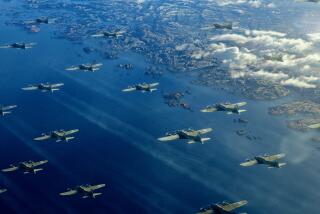Due in Long Beach Today : Right Stuff for Re-Creation of a Cross-Country Flight
In 1911, having tried transportation by motorcycle, horse, Panhard roadster and sailboat, a tough American original found a new way of getting from New York to California.
He flew.
Calbraith Perry Rodgers went from fall to winter while doing it, stopped in 76 towns, crashed 15 times and his actual time in the air to Long Beach was 82 hours plus change.
Today, knock on wood and winds willing, James Robert Lloyd should be flying a similar bird-cage biplane into Long Beach. His 75th anniversary re-creation of that first hop, skip and continental crossing by Rodgers began in September. Lloyd’s flying time to Long Beach will be more than 100 hours.
So much for the progress of modern aviation.
“The problem, in terms of time taken, is that we didn’t get the (good) weather,” Lloyd said last week. He’d just puttered and flapped and crabbed into a crosswind landing at Deer Valley Airport north of Phoenix. “There were floods in Indiana, Illinois and Oklahoma. Everywhere we went people were saying it was the worst fall in history. In Deming, N.M., where it never rains, it rained for 2 1/2 days.
“So during the first 30 days of the flight there were only four good flying days, which meant we were flying in marginal weather most of the time and living with one weather delay after another.”
Additional time was consumed by Lloyd’s commitment to pause at the same spots touched by Rodgers, fewer suburbs and hamlets (such as Covina Junction, once somewhere between Pomona and Pasadena) munched by urban encroachment. Then there was Lloyd’s obligation to a sponsor to be at certain places by agreed times and for precise ceremonial periods.
“Also, we added a few spots such as the cow pasture in Missouri when I lost a spark plug wire. That’s when you start crossing built-up areas by flying from field to field, open lot to open lot, because when your engine has given you the silent treatment twice, you tend to take a different view of routing.”
On the other hand, Lloyd has been forced down only a couple of times since leaving Hoboken, N.J., Sept. 17. Rodgers was cut, crushed, concussed and almost crippled by his many crashes. Lloyd’s major injury has been a rip in the back of his trousers, a somewhat embarrassing wound when one is flying by the seat of the very same pants.
Rodgers’ machine--the Vin Fiz after a grape pop marketed by sponsoring Armour Food Co. of Chicago--reached the West Coast with only the oil drip pan, one strut and the tail section left from the original.
Lloyd’s airplane--also the Vin Fiz and still sponsored by Armour Food despite its corporate switch to Omaha and hot dog production--should arrive quite intact.
Rodgers was pursued by a railroad car containing, among others, his wife Mabel and a mechanic named Charles Wiggin. Four months after the transcontinental flight, the pioneer pilot and his Wright Flyer crashed in the ocean off Long Beach. Rodgers was killed and his widow married the mechanic.
Lloyd’s chase crew is aboard a van and a rental car containing, among others, his wife Susan and a mechanic named Jack McCornack. But Lloyd, once safely in Long Beach, doesn’t intend to risk his life on further joy riding. He’s going back to Fishkill, N.Y., and his job as a research engineer for IBM and he’s taking Susan with him.
There are limits, said Lloyd, agreed Susan, echoed Jack, on what a team will do as its investment in history and authentic re-creation.
Calbraith Perry Rodgers, 32, tall, good-humored, sensitive, Pittsburgh-born, lived in the humbling shadow of adventuring ancestry.
It included Adm. Oliver Hazard Perry, hero of the Battle of Lake Erie and a single but signal entry in Bartlett’s Familiar Quotations: “We have met the enemy, and they are ours.” Cal Perry’s father, although killed by lightning, was a U.S. Cavalry officer on Indian patrol in the Wyoming Territory at the time.
Maybe it was a need to emulate his legacy, aviation historians say, that drove Calbraith Rodgers to race horses, yachts, motorcycles, automobiles, and then other pilots daring to be the first to cross the United States by air.
James Robert Lloyd, 38, tall, good-humored, sensitive, also Pittsburgh-born, is the son of Agnes and Bob Lloyd. His dad is a staff announcer for ABC in New York.
Lloyd was a kid model maker who has become a 300-hour private pilot with a passion for aviation lore. One day, while talking about the approaching 75th anniversary of Rodgers’ flight, Lloyd decided to re-create it.
Chance for Adventure
“First, it was my chance to have an aeronautical adventure, a full-fledged adventure, the kind that are difficult to have any more,” Lloyd explained. “Second, I feel that Cal Rodgers didn’t get the full credit he deserved and this (commemorative flight) might help change that.
“And, just like being a kid again, I’d get to dress up and look like Cal Rodgers.”
Lloyd certainly has done that. He’s flying in a three-piece, brown, houndstooth suit of the era. With vest over shirt over sweater over layers of underwear. Gauntlets, of course. And cloth cap and goggles and so what if his eyepieces were originally designed as protection from racquetballs?
His airplane, built by a Massachusetts designer of ultralight aircraft, is an improvisation. It began life as an ultralight powered by a 30-horsepower snowmobile engine. But it has been broadened and stretched into a pusher biplane, just like the original Vin Fiz, and is definitely bugs-in-the-teeth-type flying.
Look closely and you’ll notice its wheels are from a motocross bicycle (“break a wheel and you just cross the street to K mart”) and the control pulleys came from a sailboat shop. “But if you stand back 200 yards and squint,” Lloyd instructed, “it does look like a Wright Flyer.”
Just One Pitch
Rodgers made just one pitch to Armour for sponsorship and, three-quarters of a century later, so did Lloyd. Now as then, the pilots chose altitudes barely in excess of 1,000 feet at speeds of about 50 m.p.h.
“If I was passing trucks I knew I was doing more than 60 miles per hour,” Lloyd said. “Then there were times I was flying into head winds when I knew I had ground speeds as slow as 25 miles per hour.
“Once I was a little too close to a storm and got caught in an updraft of about 1,000 feet per minute. I put the nose down and that should have given me about 50 miles per hour but I knew I was actually standing still.”
Rodgers flew with a bottle of Vin Fiz taped to a wing strut for good luck and added hype. So is Lloyd.
“It’s not really a Vin Fiz bottle because as far as we know, there are only three of those still around,” Lloyd said. “But it does have the name Armour on it and that’s good enough.”
Rodgers whistle-stopped lesser communities (Streator, Blue Springs, Bobo, Waxahachie) between heftier cities (Kansas City, Phoenix, El Paso) on his 4,231-mile odyssey and took a wrong turn south to Scranton, Pa. Lloyd has duplicated the route exactly, even that wrong turn to Scranton.
Rodgers met kids who helped push Vin Fiz and signed their names on its wings. Seventy-five years later, Lloyd has met dozens of those same persons. They got to sign their names again and have been bringing their great-grandchildren to see this second Vin Fiz.
One, Lloyd said, was Clarence Johnson of Bobo, Ind.
“He was 21 years old when Cal came through and was one of the people who pushed the airplane out for takeoff. Now he’s 97.”
Rodgers’ mother Maria joined her son’s flight in mid-adventure. So did Lloyd’s mother, Agnes, when her son’s reenactment reached Oklahoma City.
Rodgers flew nowhere without a cigar between his teeth.
That, however, was where Lloyd drew another line against history.
“I don’t smoke,” he said. “There was a guy in Middletown, N.Y., who gave me a box of bubble gum cigars. But they were dreadful, certainly as bad as the real thing.”
Cal Rodgers crashed in Middletown, N.Y., one day after takeoff, and 4,000 miles later in Compton on what should have been the final leg of his hopscotch crossing.
In between he smacked into a barbed wire fence in New York and a cactus in Texas and his engine blew up over Imperial Junction and he was attacked by an eagle near Dallas and a bull in Indiana charged his machine . . .
Lloyd has had his problems, too.
“I did fly in formation with a flock of Canada geese, maybe a couple of dozen, and I was only going slightly faster than they were.”
There was a damaged undercarriage in Illinois.
“I landed in a bean field right after a rainstorm and my landing roll in the mud was about nine feet and you know what that does to landing gear.”
There was the shortest flight of them all.
“It lasted about six minutes coming out of Marshall, Mo., when I lost a spark plug wire a mile from the airport and went down to visit some cows. They just came up and looked, but they didn’t try to eat the airplane.”
Then there was the kiss of the spider people.
Draped in Spider Webs
“Flying spiders. I’d never heard of them until I flew into them over Illinois. At one time I landed and the plane was just draped in spider webs.”
Yet the thrill of the meander, Lloyd said, has had nothing to do with peril.
It has been living the nation’s geography and seeing the sense of community that exists in our country. Maybe not in larger centers, such as Phoenix, where only a half dozen persons showed up to greet Lloyd. “But certainly at Aldine, Ind., where we got 400 people, more than 10 times the population of the town,” Lloyd said.
Thompson, Mo., population 100: the whole town showed up. Middletown, Ill.: school was let out for the day and Lloyd and his crew were invited to a pot luck dinner in the church. Kent, Ohio, near Akron: “What I got from them was: ‘Wow, what this thing (flight) has done is bring our town together.’ ”
And, Lloyd agreed, in many villages his landing was the brightest excitement since . . . well, since Cal Rodgers went through in 1911.
It was these ordinary Americans, especially the youngsters, who got through to Rodgers.
“There was one little girl he met in Binghamton, N.Y. She had long red hair and Cal walked over and told her what pretty hair she had. I think he even got a lock of her hair and wrote to her throughout the trip.”
The children were still there for Lloyd.
“There was a little girl in Great Valley, N.Y.,” Lloyd remembered. “She was retarded. She walked up to me from among 300 or 400 people and said: ‘I’ve never met a movie star before.’
“And then she asked: ‘Am I pretty?’ Something like that is hard to take. It still is.”
More to Read
Sign up for The Wild
We’ll help you find the best places to hike, bike and run, as well as the perfect silent spots for meditation and yoga.
You may occasionally receive promotional content from the Los Angeles Times.






